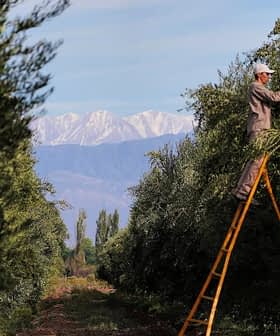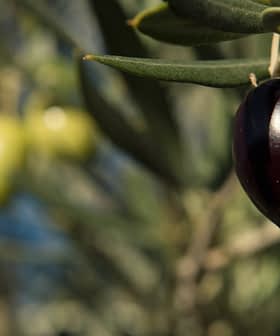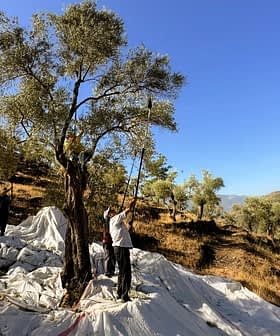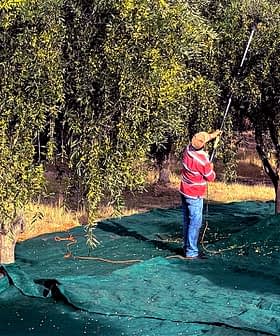Drought in Australia Portends Tough Season Ahead for Small Growers
While the overall sector is likely to remain largely unaffected, small growers on the eastern seaboard may bear the brunt of the drought.
 Murray River
Murray RiverThe drought in New South Wales and other parts of Australia’s eastern seaboard continues to worsen, with the Australian Olive Association expressing concern over potential damage to crops and profits. While the drought has already led to lower olive oil yields in the state, the impact on the quality and quantity of this year’s crop will depend on whether or not there is significant rain before the trees flower in October.
New South Wales (NSW) and other parts of Australia’s eastern seaboard continue to be ravaged by a drought that shows no signs of letting up.
While things look grim right now, one good rain event could make an enormous difference to the 2019 crop.
While the prolonged dry spell has wreaked havoc on ranchers and grain farmers, some of the state’s small olive growers and oil producers are wary that their crops and profits may be damaged as well.
According to the Australian Bureau of Meteorology, NSW has experienced its driest winter since 2002 and driest year since 1965.
Hot and dry conditions led to lower olive oil yields in the state during the previous harvest season. About 20 percent of Australia’s olive growers are located in NSW. Another 40 percent are located in Queensland, Victoria and Tasmania, all of which have suffered from the drought.
“The prolonged hot, dry conditions at flowering in 2017, and particularly during the ripening period in 2018, contributed significantly to low yields for the 2018 season,” Greg Seymour, the CEO of the Australian Olive Association, told Olive Oil Times.
However, the state’s olive trees will not flower until October. Whether or not there is rain between now and then will completely change olive growers’ fortunes.
“It is too early to tell [if the coming year’s oil yield or quality will be affected by the drought],” Seymour said. “An assessment post flowering will give us a much clearer indication of what we can expect.”
The Australian Olive Association will head out for a series of field days in November, which will give them a good idea of how this harvest season’s olive yield will look.
“While things look grim right now, one good rain event could make an enormous difference to the 2019 crop,” Seymour added.
The latest forecasts from the Bureau of Meteorology predict that the drought will continue well into the summer. Andrew Watkins, one of the Bureau’s meteorologists, warned farmers to brace for a hotter and drier spring than usual. He also said that drought conditions are forecasted to intensify across the country.
“[We are] looking at average to below-average rainfall, unfortunately, for the drought areas and warmer-than-average conditions through those areas as well,” Watkins told reporters at a recent press conference.
He expects that NSW will be one of the states most affected by the drought, which may be compounded during the summer months if El Niño forms. According to meteorologists, there is about a 50 percent chance that will happen.
“This will basically mean that as we get into summer, there’d be less chance of having those recovery rains that we need,” Watkins said. “We might have to wait until as late as autumn in 2019 to start seeing some recovery rains in the drought areas.”
However, NSW did receive some rain in August, which came as a pleasant reprieve for local olive growers.
“Hopefully it’s enough to carry us through,” Jayne Bentivoglio, the CEO of Rylstone Olive Press, told Olive Oil Times. “We are struggling with water everywhere. We are currently in drought watering mode, so we’re buying water and bringing it in from elsewhere.”
Bentivoglio grows 8,000 olive trees at a farm located 3.5 hours northwest of Sydney. She only irrigates about half of her trees due to how expensive buying water is. Bentivoglio said the drought is more likely to impact the quantity of olives she will have to harvest next autumn, not the quality of the resulting oil.
“I may not always get a crop, but when I do the quality is always of an award-winning standard,” she said.
To determine whether or not the quality of the oil will be affected, Bentivoglio will need to wait until February. This is when the flesh underneath the skin of the olives develops. If February is very dry then the flesh growth will be inadequate and the resulting oil will be of lower quality.
While there are not yet any reports circulating about the effects of the drought on Australian olive groves, how badly olive farmers will be impacted largely depends on how they irrigate their trees.
“I would expect that those groves relying on local surface catchment for irrigation water will be affected as they are unlikely to have full dams at the start of the growing season unless some significant rain events take place in the near future,” Leandro Ravetti, the technical director of Modern Olives, told Olive Oil Times.
“Those growers relying on bore water or water from larger irrigation systems, such as the Murray-Darling basin, will not be affected by the drought as the water supply is quite certain,” he added.
The Murray-Darling basin stretches throughout NSW and Victoria and is also partially located in South Australia and Queensland.
While some small olive growers in Victoria and South Australia told Olive Oil Times that they do not expect to experience much of an impact from the drought, others are concerned that their production costs will increase sharply with water prices.
Unlike other olive producing countries where the government has stepped in to provide assistance during times of drought, the Australian government has not. It has instead focussed its attention and resources on ranchers.
“It’s pretty hard to get money out of the government, especially for small growers,” Bentivoglio said. “There’s no government help for olive growers.”
In spite of the impacts of the drought, Seymour believes there will not be a drop-off in productivity for the overall Australian olive oil sector. The country is entering an on-year and large olive oil producers in western Australia have largely escaped the effects of the drought.
“If BBO and western Australia have a good year in 2019, which is looking like a good possibility, then the impact on the Australian olive oil sector in terms of volume will not be all that significant,” Seymour added, referring to Boundary Bend Olives, the largest olive oil producer in Australia.
However, small producers in the east — especially in NSW — will be the ones feeling the brunt of the drought, both in the groves and on their bottom lines.
“The impact will be felt by individual small producers rather than the industry,” Seymour said.









